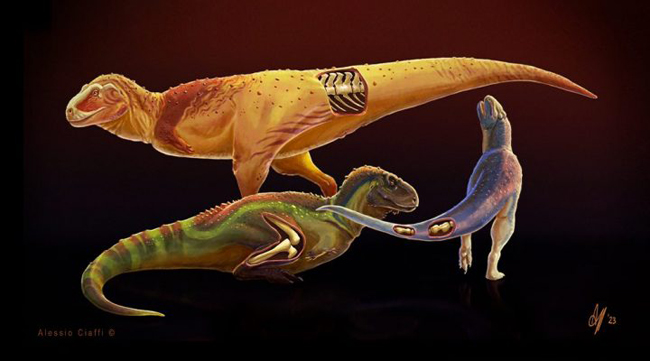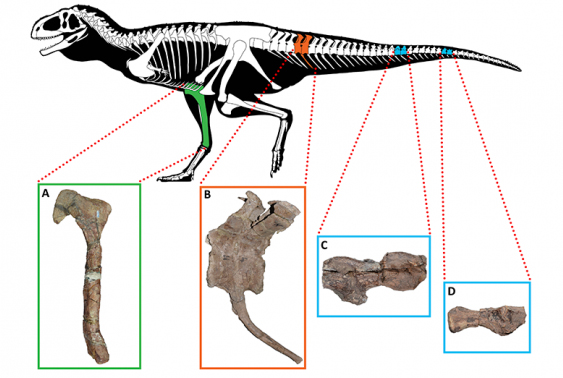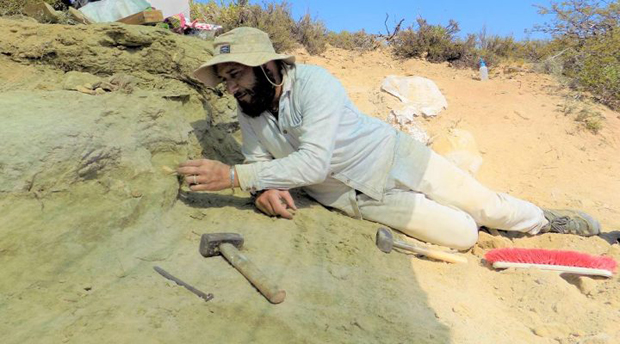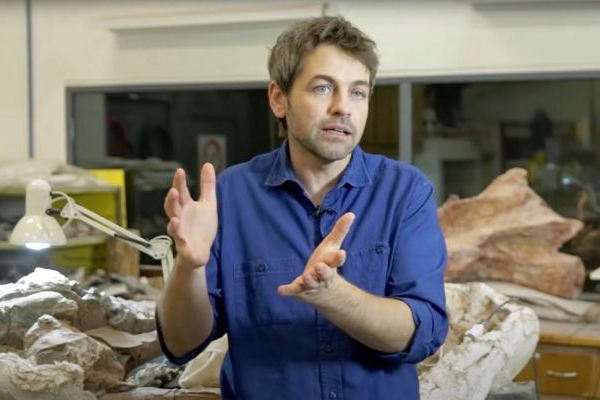A new study has provided fresh insights into the pathologies associated with predatory dinosaurs. Researchers have examined in forensic detail the pathologies associated with three South American abelisaurids. In addition, the scientists have compiled a comprehensive database of theropod dinosaur fossil pathologies. This database may shed light on the behaviour of different types of theropod. For example, allosaurids had a great frequency of fractures. This suggests that these carnivorous dinosaurs were extremely active, and this might infer a relation to hunting strategies and behaviours. It may also indicate the type of prey that allosaurids tackled.
The three abelisaurid dinosaurs examined in this research were Elemgasem nubilus, Aucasaurus garridoi and Quilmesaurus curriei. These three predatory dinosaurs all lived in Patagonia during the Late Cretaceous.

Life reconstruction of the abelisaurs involved in this study. Aucasaurus garridoi (A) MCF-PVPH-236 (congenital malformation in anterior caudal vertebrae). Elemgasem nubilus (B) MCF-PVPH-380 (spondyloarthropathy in middle and posterior caudal elements). Quilmesaurus curriei(C) MPCA-PV-100 (possible pathology in the right tibia). Picture credit: Alessio Ciaffi.
Picture credit: Alessio Ciaffi
The research project conducted by scientists from CONICET has revealed new details of the pathologies associated with theropods. The research has been published in the journal BMC Ecology and Evolution.
A Study Consisting of Three Phases
The palaeontologists noticed deformations on the external surface of some bones at a macroscopic level, especially in the caudal vertebrae of the Elemgasem and Aucasaurus specimens. This finding led to the hypothesis that these deformations resulted from possible pathologies. The team decided to conduct a more detailed examination of the morphology of the fossilised bones. The internal structure was also examined at the microscopic level.
The research programme was split into three distinct phases. Firstly, the external structure of the bones showing potential pathologies was examined. Secondly, bone histology on the Quilmesaurus and Elemgasem specimens was undertaken whilst CT scans were carried out on the Aucasaurus fossils to evaluate how possible pathologies had affected surrounding tissues.

A specimen of the abelisaurid Aucasaurus garridoi was found to have a congenital developmental disease, despite which the animal was able to live for many years. Picture credit: Alessio Ciaffi.
Picture credit: Alessio Ciaffi
A Database of Diseases and other Pathologies of Predatory Dinosaurs
The detailed analysis revealed three distinct types of pathologies. The Aucasaurus specimen had a congenital developmental disease, which indicated that this individual was born with a malformation that, despite this, allowed the animal to live for many years. In the case of Elemgasem, spondyloarthropathy or spondyloarthritis was diagnosed, a disease also present in humans, which causes the fusion of vertebrae and the consequent inflammation. On the other hand, the Quilmesaurus specimen showed signs of some pathology that could not be precisely determined. This pathology seemed different from those identified in the other two abelisaurids.
This work led onto the third phase of the study. The team compiled a database which documented all the known cases of pathologies in theropod dinosaurs. Statistical analysis provided the scientists with potential insights into theropod lifestyle and behaviour. For instance, the high number of fractures observed in the Allosauridae. In addition, tyrannosaurids had bite marks which resulted in infections such as trichomonosis. The incidence of bite marks in tyrannosaurs suggests that tyrannosaurids indulged in very aggressive intraspecific social behaviour.
To read an earlier article from Everything Dinosaur documenting trichomonosis in an iconic T. rex specimen: Some Tyrannosaurs Suffered from Parasitic Infections.
Corresponding author of the newly published paper, Mattia Antonio Baiano (Ernesto Bachmann Municipal Museum) commented:
“This work not only expands our knowledge about dinosaur health, but also highlights the presence of diseases that persist today, suggesting possible connections between the study of extinct organisms and the research of contemporary diseases.”
Picture credit: Courtesy of the Researchers
A Fresh Perspective on the Lives of Predatory Dinosaurs
The research team concluded that statistical examination of the distribution of injuries associated with different theropod families could provide a fresh perspective regarding theropod behaviour. Different lifestyles and behaviours may underlie the frequency of different injuries among theropod taxa.
Co-author Diego Pol, CONICET researcher at the “Egidio Feruglio” Paleontological Museum added:
“It is a very interesting work since it brings together specialties from different researchers and tries to discover a little of the marks left on the skeleton by the behaviours of dinosaurs.”
Picture credit: Courtesy of the Researchers
Everything Dinosaur acknowledges the assistance of a media release from CONICET in the compilation of this article.
The scientific paper: “New information on paleopathologies in non-avian theropod dinosaurs: a case study on South American abelisaurids” by Mattia A. Baiano, Ignacio A. Cerda, Filippo Bertozzo and Diego Pol published in BMC Ecology and Evolution.
The Everything Dinosaur website: Dinosaur Toys and Models.








Leave A Comment